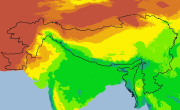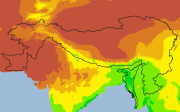climatologyMeteorologyAtmosphere
Type of resources
Available actions
Topics
Keywords
Contact for the resource
Provided by
Years
Representation types
Update frequencies
status
Scale
Resolution
-
Average data for Whole Indus from year 1991 to 2000 for the month of August in ASCII format. It is an Aphrodite data with 0.25 resolution in x and y direction. The APHRODITE project develops state-of-the-art daily precipitation datasets with high-resolution grids. The datasets are created primarily with data obtained from a rain-gauge-observation network.
-

Digital grid dataset of monthly maximum temperature (April) for the period of 1950-2000 of Hindu Kush Himalayan (HKH) Region. The dataset is derived from WorldClim (http://www.worldclim.org/), and major climate databases compiled by the Global Historical Climatology Network (GHCN), the FAO, the WMO, the International Center for Tropical Agriculture (CIAT), R-HYdronet. Monthly maximum temperature data set consists of 12 raster files, one for each month, showing mean values derived from monthly temperature readings. The data layers were generated through interpolation of average monthly climate data from weather stations on a 30 arc-second resolution grid
-

Digital grid dataset of monthly precipitation (August) for the period of 1950-2000 of Hindu Kush Himalayan (HKH) Region. The dataset is derived from WorldClim (http://www.worldclim.org/), and major climate databases compiled by the Global Historical Climatology Network(GHCN),the FAO, the WMO, the International Center for Tropical Agriculture (CIAT), R-HYdronet. Monthly Precipitation data set consists of 12 raster files, one for each month, showing mean values derived from monthly precipitation readings. The data layers were generated through interpolation of average monthly climate data from weather stations on a 30 arc-second resolution grid.
-

Daily mean sunshine duration of October 2001 of Nepal. This dataset is created using actual daily sunshine averages using Win-surfer and GIS-arc/info software packages. The mean values were derived from daily sunshine readings.
-
Average data for Whole Indus from year 1981 to 1990 for the month of January in ASCII format. It is an Aphrodite data with 0.25 resolution in x and y direction. The APHRODITE project develops state-of-the-art daily precipitation datasets with high-resolution grids. The datasets are created primarily with data obtained from a rain-gauge-observation network.
-
Average data for Whole Indus from year 1981 to 1990 for the month of July in ASCII format. It is an Aphrodite data with 0.25 resolution in x and y direction. The APHRODITE project develops state-of-the-art daily precipitation datasets with high-resolution grids. The datasets are created primarily with data obtained from a rain-gauge-observation network.
-

Digital grid dataset of monthly precipitation (October) for the period of 1950-2000 of Hindu Kush Himalayan (HKH) Region. The dataset is derived from WorldClim (http://www.worldclim.org/), and major climate databases compiled by the Global Historical Climatology Network(GHCN),the FAO, the WMO, the International Center for Tropical Agriculture (CIAT), R-HYdronet. Monthly Precipitation data set consists of 12 raster files, one for each month, showing mean values derived from monthly precipitation readings. The data layers were generated through interpolation of average monthly climate data from weather stations on a 30 arc-second resolution grid.
-
This sensor measures precipitation volumes with the tipping technique, where each signal is a fixed volume of water. It is located below Ganja La Pass in Langtang Valley. It is part of a transect of three sensors, between Kyanjing Village and High camp.
-

Average delta change for monthly mean air temperature (Tavg), monthly maximum air temperature (Tmax), monthly temperature (Tmin) and monthly precipitation (P). This dataset has a monthly temporal resolution spanning 42 years from 1 January 2008 to 31 December 2050 and a spatial resolution of 25x25 km. RCP 4.5(model available BNU-ESM_r1i1p1, inmcm4_r1i1p1, CMCC-CMS_r1i1p1, CSIRO-Mk3-6-0_r4i1p1) ; RCP 8.5(model available inmcm4_r1i1p1, CMCC-CMS_r1i1p1, bcc-csm1-1_r1i1p1, CanESM2_r3i1p1).
-

Digital grid dataset of monthly maximum temperature (November) for the period of 1950-2000 of Hindu Kush Himalayan (HKH) Region. The dataset is derived from WorldClim (http://www.worldclim.org/), and major climate databases compiled by the Global Historical Climatology Network (GHCN), the FAO, the WMO, the International Center for Tropical Agriculture (CIAT), R-HYdronet. Monthly maximum temperature data set consists of 12 raster files, one for each month, showing mean values derived from monthly temperature readings. The data layers were generated through interpolation of average monthly climate data from weather stations on a 30 arc-second resolution grid.
 Metadata Catalogue
Metadata Catalogue